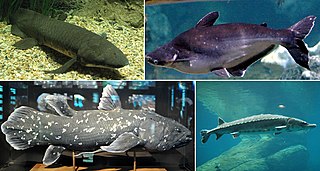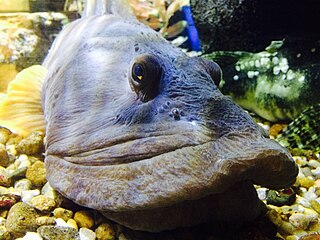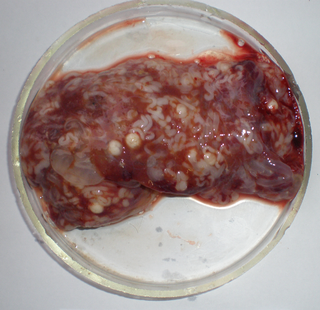
Actinopterygii, members of which are known as ray-finned fish or actinopterygians, is a class of bony fish that comprise over 50% of living vertebrate species. They are so called because of their lightly built fins made of webbings of skin supported by radially extended thin bony spines called lepidotrichia, as opposed to the bulkier, fleshy lobed fins of the sister class Sarcopterygii. Resembling folding fans, the actinopterygian fins can easily change shape and wetted area, providing superior thrust-to-weight ratios per movement compared to sarcopterygian and chondrichthyian fins. The fin rays attach directly to the proximal or basal skeletal elements, the radials, which represent the articulation between these fins and the internal skeleton.

Osteichthyes, also known as osteichthyans or commonly referred to as the bony fish, is a diverse superclass of vertebrate animals that have endoskeletons primarily composed of bone tissue. They can be contrasted with the Chondrichthyes and the extinct placoderms and acanthodians, which have endoskeletons primarily composed of cartilage. The vast majority of extant fish are members of Osteichthyes, being an extremely diverse and abundant group consisting of 45 orders, over 435 families and 28,000 species. It is the largest class of vertebrates in existence today, encompassing most aquatic vertebrates, as well as all semi-aquatic and terrestrial vertebrates.

The Tetraodontiformes are an order of highly derived ray-finned fish, also called the Plectognathi. Sometimes these are classified as a suborder of the order Perciformes. The Tetraodontiformes are represented by 10 extant families and at least 349 species overall; most are marine and dwell in and around tropical coral reefs, but a few species are found in freshwater streams and estuaries. They have no close relatives, and descend from a line of coral-dwelling species that emerged around 80 million years ago.

The ocean sunfish or common mola is one of the largest bony fish in the world. It was misidentified as the heaviest bony fish, which was actually a different and closely related species of sunfish, Mola alexandrini. Adults typically weigh between 247 and 1,000 kg. The species belongs to the Mola genus, one of three in the Molidae family. It is native to tropical and temperate waters around the world. It resembles a fish head without a tail, and its main body is flattened laterally. Sunfish can be as tall as they are long when their dorsal and ventral fins are extended.

The Molidae comprise the family of the molas or ocean sunfishes, unusual fish whose bodies come to an end just behind the dorsal and anal fins, giving them a "half-fish" appearance. They are also the largest of the ray-finned bony fish, with the southern sunfish, Mola alexandrini, recorded at 4.6 m (15 ft) in length and 2,744 kg (6,049 lb) in weight.

Oarfish are large, greatly elongated, pelagic lampriform fish belonging to the small family Regalecidae. Found in areas spanning from temperate ocean zones to tropical ones, yet rarely seen, the oarfish family contains three species in two genera. One of these, the giant oarfish, is the longest bony fish alive, growing up to 17 m (56 ft) in length.

Opahs, also commonly known as moonfish, sunfish, kingfish, and redfin ocean pan are large, colorful, deep-bodied pelagic lampriform fishes comprising the small family Lampridae.

The slender sunfish is a mola of the family Molidae, the only extant member of the genus Ranzania, found globally in tropical and temperate seas. Its length is up to 1 m (3.3 ft). Several stranding and mass stranding events have occurred on beaches near Albany, Western Australia.

A sunfish, also called a mola, is any fish in the genus Mola. The fish develop their truncated, bullet-like shape because the back fin, which is present at birth, never grows. Instead, it folds into itself as the creature matures, creating a rounded rudder called a clavus. Mola in Latin means "millstone" and describes the ocean sunfish's somewhat circular shape. They are a silvery color and have a rough skin texture.

The ocean pout is an eelpout in the family Zoarcidae. It is found in the Northwest Atlantic Ocean, off the coast of New England and eastern Canada. The fish has antifreeze proteins in its blood, giving it the ability to survive in near-freezing waters.

Eomola is an extinct genus of sunfish from the upper Eocene. Its fossils have been found in Russia. Eomola was described in 1992 by James Tyler and Alexandre Bannikov, and the type species is E. bimaxillaria.

Aqua World, formerly the Ibaraki Prefectural Oarai Aquarium, is a 19,800 square metres (213,000 sq ft) aquarium in the Higashiibaraki District of Ibaraki Prefecture, Japan, north of Oarai port at the mouth of the Naka River.

Cantherhines dumerilii is a species of fish in the family Monacanthidae, the filefishes. Its common names include whitespotted filefish, barred filefish, orange-fin file, and yelloweye leatherjacket. It is distributed in the Indian and Pacific Oceans where it is found on coral reefs.

The sharptail mola is a species of mola found circumglobally in tropical and temperate waters. It is similar in appearance to the ocean sunfish, but can be distinguished by the projection on its clavus (pseudo-tail). Other common names include sharpfin sunfish, point-tailed sunfish, and trunkfish. Rarely encountered, very little is known of the biology or life history of the sharptail mola. It has recently become important to commercial fisheries operating off eastern Taiwan. This species is the only member of its genus.

The giant sunfish or bumphead sunfish, , is a fish belonging to the family Molidae. It is closely related to the more widely known Mola mola, and is found in the Southern Hemisphere. With a specimen found dead near the Azores in 2021 weighing in at 2744 kg it is the largest extant bony fish species in terms of maximum recorded mass by a wide margin. It can be found basking on its side occasionally near the surface, which is thought to be used to re-heat themselves after diving in cold water for prey, recharge their oxygen stores, and attract gulls to free them of parasites.

Carybdea murrayana, the South African box jellyfish, is a venomous species of cnidarian, in the small family Carybdeidae within the class Cubozoa.

Molicola horridus is a species of tapeworm. The adult worm is found in the spiral valve in the lower part of the intestine of the blue shark. The larvae are found infesting the livers and muscles of ray-finned fishes such as the ocean sunfish, and the spot-fin porcupinefish.
Marianne Nyegaard is a Danish marine biologist who specializes in the study of ocean sunfish. She is known for identifying the ocean sunfish species Mola tecta.




















